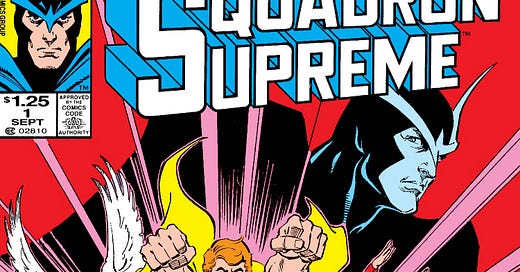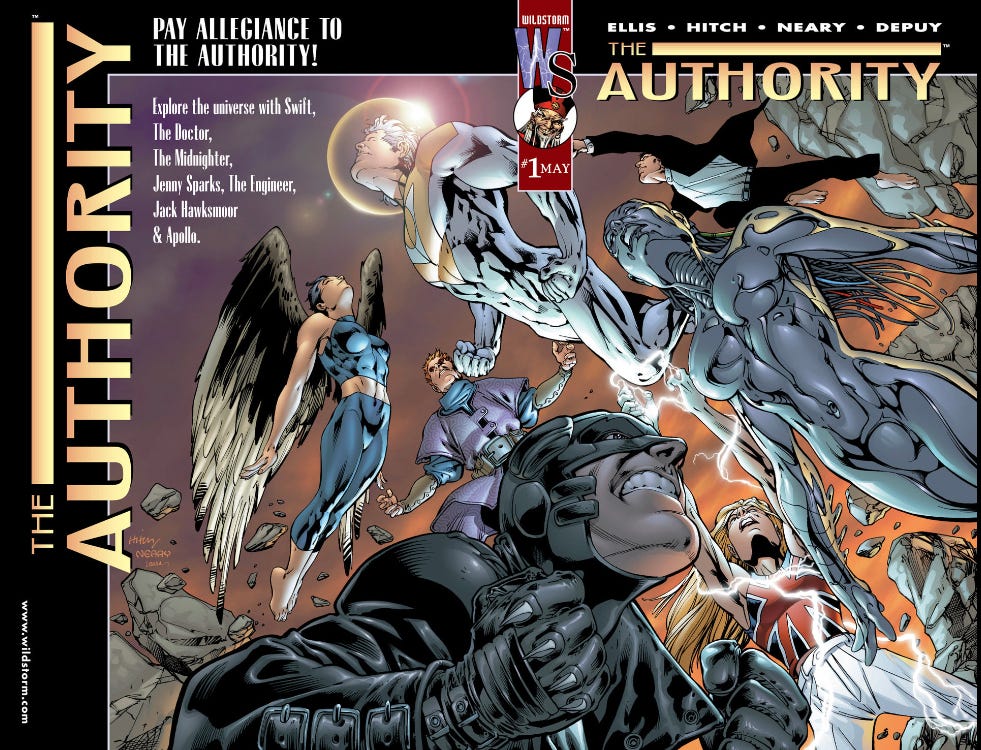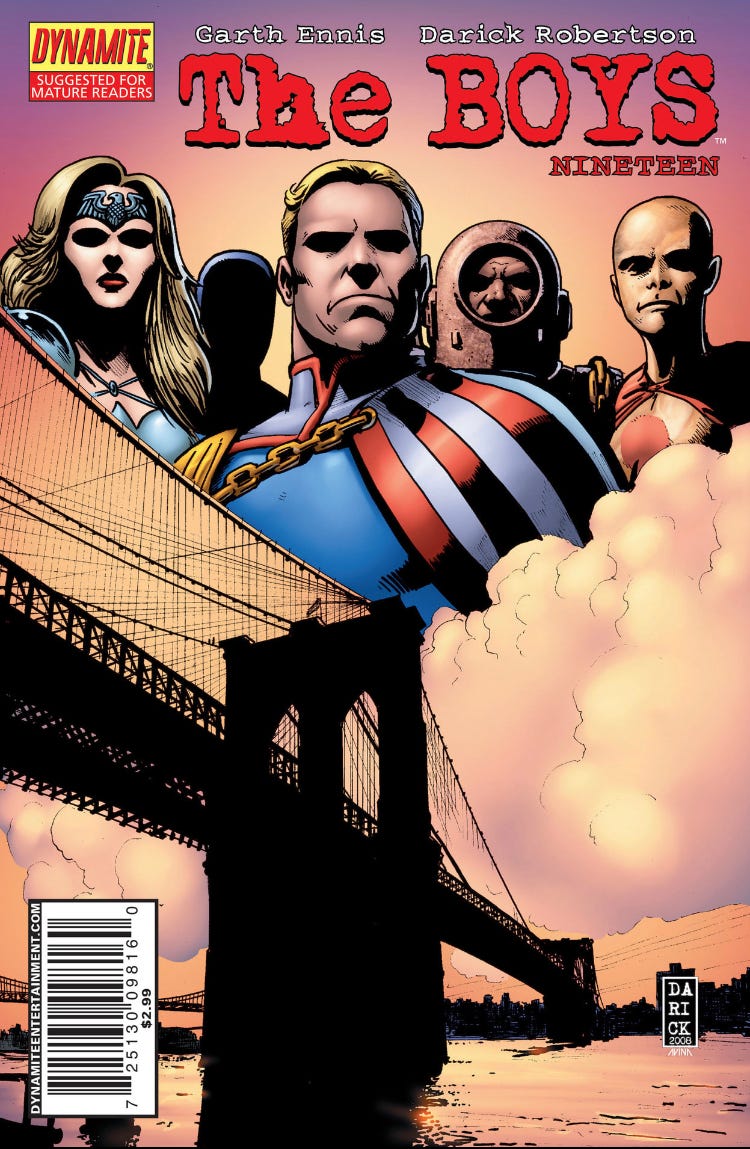The Kinda, Sorta, But Not Really Justice Leagues
The most famous super team is also the most frequently spoofed
Superman. Batman. Wonder Woman. They are the Holy Trinity of DC Comics and the most famous members of the Justice League. They are global icons that transcend comic books and have become synonymous with superheroes writ large. Being so popular and recognizable also makes them ripe for parody and satire, and many different creators in comics, film, and television have done exactly that. The following are examples of some of my favorite and most popular instances of the Justice League being parodied.
The Squadron Supreme
It should come as no surprise that one of the earliest examples of stand ins for the Justice League appearing in another comic book came courtesy of Marvel Comics, DC Comics’ biggest competitor. In Avengers #69 (published in 1969) from Roy Thomas and Sal Buscema, the Avengers fight a team of supervillains created by the Grandmaster called the Squadron Sinister. Their members include Hyperion (Superman), Nighthawk (Batman), Doctor Spectrum (Green Lantern), and Whizzer (Flash). Following their defeat, Roy Thomas and John Buscema (yes, both Buscemas are involved) would then create a heroic version of the team from an alternate universe in Avengers #85 (published in 1971) called the Squadron Supreme. This team would go on to make multiple appearances usually as a foil for the Avengers (whether due to misunderstandings or mind control) mostly as an excuse to give fans a tease about how a fight between the Avengers and Justice League would go. Future members of the team would include Power Princess (Wonder Woman), Amphibian (Aquaman), Skrullian Skymaster (Martian Manhunter), and many others.
In 1985, the Squadron Supreme would get their own twelve issue series written by Mark Gruenwald with pencils by Bob Hall, Paul Ryan, and John Buscema appropriately titled Squadron Supreme. Gruenwald would use these archetypal characters to tell a story about what would happen if a group of godlike heroes decided to take over the world in order to keep it safe. It’s one of the earliest examples of a comic creator deconstructing the superhero mythos to tell a more mature and nuanced story (Watchmen by Alan Moore and Dave Gibbons would begin publication the following year in 1986). Nighthawk (the Batman stand in) would lead the resistance against the totalitarian world government of Hyperion (the Superman stand in). It should be noted that this also predates The Dark Knight Returns by Frank Miller (also published in 1986).
The Squadron Supreme would get its own series once again in 2003. Written by J. Michael Straczynski with pencils by Gary Frank, Supreme Power would attempt to tell an adult oriented story through the Marvel MAX line of comics about what would happen if the classic origin stories for the Justice League happened in the real world. In this reality, a young Hyperion (Superman) would be raised by the United States government instead of a kindly elderly couple. Nighthawk (Batman) is a Black man orphaned when his parents are killed in a hate crime. Power Princess (Wonder Woman) believes herself to be a goddess worthy of subjugating humanity. Doctor Spectrum (Green Lantern) is a special forces operative with the United States Army who gains his powers through government experiments using crystals found in Hyperion’s crashed ship. Amphibian (Aquaman) is essentially a female Creature From the Black Lagoon who was abandoned as a child due to her strange appearance. These are all broken people who inspire fear more than hope among the populace.
The Squadron Supreme in its many iterations continues to appear in various Marvel titles (most recently showing up in Jason Aaron’s Avengers run). It seems like only a matter of time until they end up in the Marvel Cinematic Universe as well.
The Authority
It’s one thing for Marvel Comics to publish satirical versions of the Justice League seeing as how they are chief rivals. It’s another thing entirely for DC Comics to publish their own satirical takes on their flagship characters. That’s what makes the Authority such a unique super team. The Authority were created by Warren Ellis and Bryan Hitch in 1999’s The Authority ongoing series for DC’s WildStorm imprint. I have discussed Ellis’s comments on the series previously, but essentially the goal was to tell sweeping epic action stories with mature content and themes using characters meant to resemble the Justice League. Most of the team members are preexisting WildStorm characters, but the notable exceptions are Apollo and Midnighter. Apollo (Superman) and Midnighter (Batman) are an openly gay celebrity couple in this series who have no qualms about using lethal force on a massive scale to defeat their enemies.
The hyper violence and crass humor would be taken to another level when Mark Millar and Frank Quitely took over the series with The Authority #13 (published in 2000). The antiheroes would show up to fights drunk, deal with homophobic insults from villains, and brutally slaughter (and sometimes torture) their foes. That tone would continue to define the team throughout the decade.
In recent years, the Authority have been folded into the main DC Comics continuity. Grant Morrison and Mikel Janin recently collaborated on a series titled Superman and the Authority (published in 2021) in which the Kryptonian tried to set a better example for the team to become more heroic and less violent. Even more recently, James Gunn has announced that The Authority will be getting their own feature film. It will be interesting to see how the team is portrayed on the big screen.
The Seven
If the previous stand ins for the Justice League were cynical yet ultimately still heroic, then The Seven are a look at what the Justice League would be if they were composed of unrepentant monsters. The Seven serve as the primary villains in Garth Ennis’s vicious satire comic The Boys. The initial lineup is composed of Homelander (Superman), Black Noir (Batman), Queen Maeve (Wonder Woman), A-Train (Flash), The Deep (Aquaman), Jack from Jupiter (Martian Manhunter), and Lamplighter (Green Lantern).
Ennis has never been shy about his disdain for superheroes, and nothing illustrates that better than his treatment of The Seven. They are little more than corporate stooges meant to boost the image of a massively powerful company called Vought. Homelander is the worst of the bunch. He is a right-wing sadist and narcissist with little to no impulse control. A person with that personality and Superman’s powers is a truly terrifying prospect.
The Boys has gained an impressive pop culture footprint thanks to the success of the television adaptation, so the cynical take on superheroes portrayed by The Seven has taken root in the mainstream cultural zeitgeist. With The Authority movie in the works, it stands to reason that satirical takes on the Justice League in film and television could become more popular than the actual Justice League movie (both versions). What a truly strange time.






